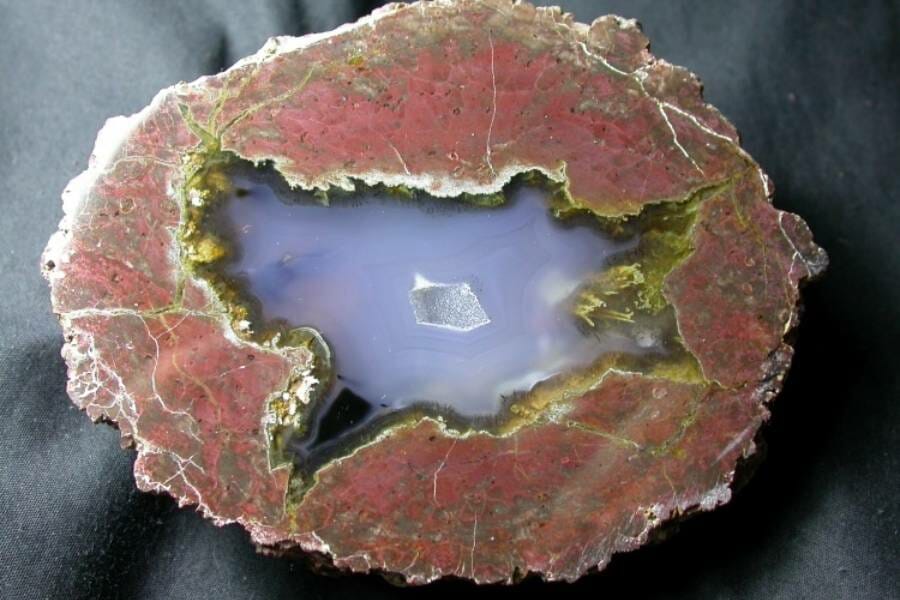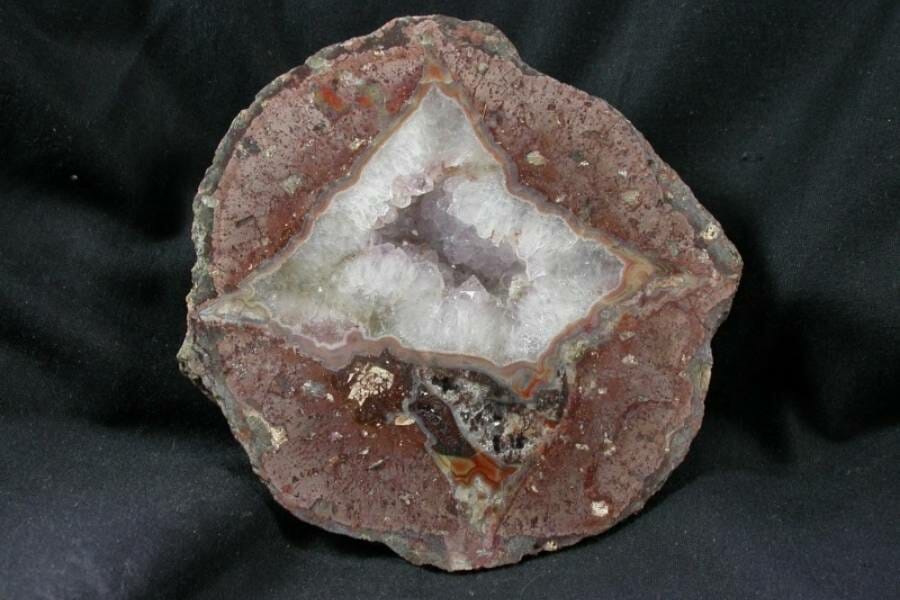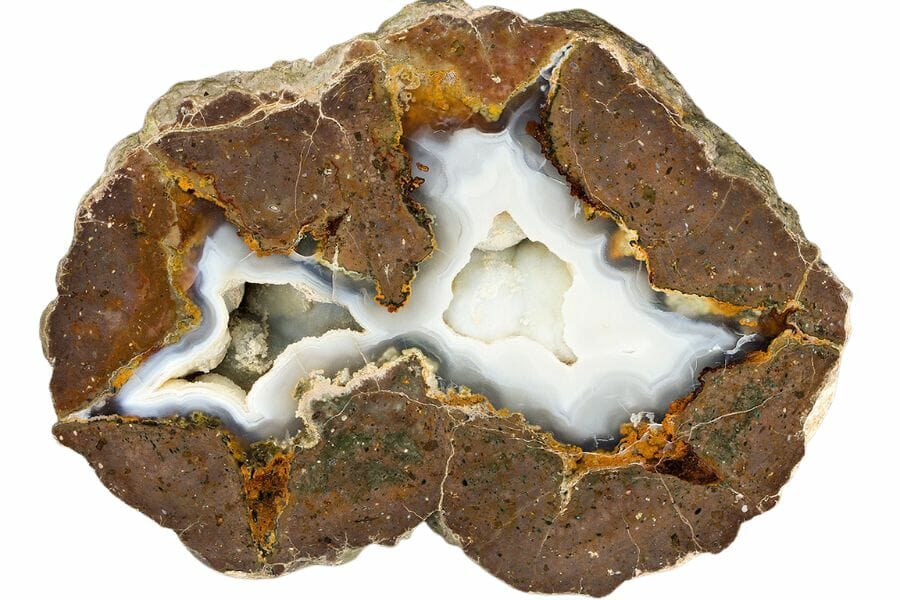Thunder eggs are one of the most beautiful and unusual geological formations found on earth. While they might look boring on the outside once you crack them open they can take your breath away.
Many amateur rockhounds have passed over thunder eggs as they search in their local areas without any clue what they missed. Fortunately, we can help you find them!
We will share our experience and expertise in locating and identifying thunder eggs, so you won’t have to mistake these lovelies for regular rocks again.
We’re ready to guide you every step of the way in your quest to locate and identify these treasured stones. Do the easiest part now – read along!
What is a thunder egg?

A thunder egg is a geological formation with a nodule-like type of rock that forms in rhyolitic (a very acidic granite rock) volcanic ash layers and resembles a full geode. They are mostly spherical and are roughly the size of baseballs, even though some can be as large as three feet across or as little as one centimeter.
The different types of thunder eggs you can find
Thunder eggs usually have chalcedony centers that may have been broken, with jasper, agate, or opal deposited in them. These treasured geological formations can be identified by their lovely interiors enclosed in a rugged exterior, but cutting them in half and polishing them can reveal complex patterns and hues.
Thunder eggs are also known as lithophysae, an igneous rock abundant in feldspar and quartz minerals in a mass of radiating crystal fibers. It is a round crystallized rock packed with chalcedony, agate, or quartz that is solid or almost solid.
There can be some other types of minerals, including gypsum and quartz, so you know there are a wide variety of shapes and colors to these crystals!
When you’re out looking for rough Thunder Eggs on your own it’s important to know what you’re looking for. But before we dive into specifically what to look for you need to make sure you understand the type of rocks and minerals you’re seeing.
So many rockhounds find some pretty incredible rocks and minerals and toss them away because they don’t know what they have.
DON'T MISS OUT ON ANY GREAT FINDS!
While you're out searching for Thunder Eggs you're going to find A LOT of other interesting rocks and minerals along the way. The last thing you want to do is toss out something really interesting or valuable. It can be easy to misidentify things without a little guidance.
You absolutely need a good reference guide in order to understand what you're looking at!
We've put together a fantastic field guide that makes identifying 140 of the most interesting and valuable rocks and minerals you will find REALLY EASY. It's simple to use, really durable, and will allow you to identify just about any rock and mineral you come across. Make sure you bring it along on your hunt!
Now, back to the identification specifics:
Where to find thundereggs

Volcanic rhyolite determines where you can find thunder eggs. Water seeping through the porous rock carrying silica in solution causes them to form in the lava! The deposits carried by the water lined and filled the cavity, adding a darker matrix material and an agate or chalcedony inner core.
This kind of rock is found in areas with complex and intricate histories of shifting environmental factors. They can sometimes also be spotted in rivers and streams, where the water may have brought them.
Where you can find thunder eggs
Some well-known locations for thunder eggs include Germany (especially at Gehlberg and St. Egidien), the United States, Argentina, Poland, Canada, Romania, and Ethiopia. Some conditions necessary for the formation of thunder eggs include magmatic composition, types of rocks in the area, groundwater geochemistry, depth, pressure, and temperature.
In Schneekopf, near Gehlberg, the porphyry-based mountain (a hard igneous rock with fine-grained crystals) is volcanic in origin. Perfect for finding thunder eggs!
At the same time, the thunder eggs nestled in Mount Lyall, in British Columbia, Canada, have a volcanic outcrop as the host rock. You can imagine the volcanic power that brought these stones out!
The 5 best thunder eggs hunting states and where to go
We recommend the following states based on their geology, the number of finds and the opportunity to join fellow rockhounds to hunt for thunder eggs.
Oregon
Here in Oregon, the host rocks are part of the volcanic arc fed by a chain of volcanoes. The huge volcanoes at the surface are fueled by hot spots, localized regions where great heat rises from deep inside the Earth. Rockhounds from Oregon chose the thunder egg as the state rock.
The most popular places to find thunder eggs in Oregon are in Eastern and Central Oregon. The Ochoco National Forest, close to Prineville and Mandras, and the Succor Creek Canyon in the East are the best and most prolific areas.
Try: Succor Creek Canyon
The location has long been regarded as Oregon’s best rockhounding location. The area is between Adrian and Jordan Valley. The area’s geology shows that the volcanic sediments from far-off explosive volcanic eruptions make up a large portion of this formation. Succor Creek boasts a lovely landscape and a lot of thunder eggs, like the petrified wood and the agate-filled thunder egg.
Check out our full guide to finding thunder eggs in Oregon for more options.
New Mexico
New Mexico is a thriving state for rockhounding, and if you are opportune to travel there, you are guaranteed a successful thunder eggs hunting experience.
Rockhounds can also explore other sites in this state to hunt for thunder eggs and other stones that abound in this state.
Try: Rockhound State Park
The popular Rockhound State Park in the Little Florida Mountains in southern New Mexico, close to Deming, is a great place to find thunder eggs of all kinds. It has the perfect conditions for creating them! Plus the park has camping grounds so you can plan a better trip.
Washington
Washington is located near the violent continental-ocean boundary by earthquakes, volcanic eruptions, and the emergence of young mountains. This explains why the state has deposits of thunder eggs.
This state has several thunder egg hunting spots, including many high-density locations in the Yakima valley. Mount Higgins, Pine/Milk Creek, Rim Rock, or the broader White River area are some locations you can explore for thunder egg hunting.
Try: Public properties in the Little Naches River basin near Yakima
All the locals know to go to the public lands and find their precious gemstones! There are a lot of thunder eggs here to find, even for a newbie. But if you’re a little more seasoned, you can push for some interesting specimens.
Our full guide to finding thunder eggs in Washington has even more places to try.
Idaho
The geology of this state is complex. The state is home to fascinating volcanic rocks, thunder eggs, minerals, crystals, and fossils. The Southwestern parts of the state remain a rockhound’s haven for thunder eggs.
Try: Hog Creek
You can hunt your amazing thunder eggs at Hog Creek, near Weiser. It is the best location in the state, and visitors can find stunning amethyst thunder eggs everywhere here. You can also find these stunning rocks at Antelope Creek, but remember to bring a lapidary saw when you come here.
How to find thunder eggs near you

Thunder eggs are found in silica-rich volcanic rocks. This means rockhounds hunting for thunder eggs must be aware that they are more likely to find them in areas that have or had volcanoes.
Common places where you can find them in this type of environment are:
Rocky outcrops
Rocky outcrops reveal a variety of fascinating rocks and minerals that are present underground. Thunder eggs can sometimes be found in this location, depending on the location’s previous geologic history. It’s best to look into what locals say for where to go to find promising geodes in these rarer locations.
Mountainous regions
Mountains’ high altitudes can expose a variety of fascinating rocks and minerals. These areas are also frequently home to rhyolite rock, the volcanic rock where they develop. Thunder eggs are commonly hunted in these areas, especially if waterways are nearby.
Pay-to-dig sites
This is the most reliable location to hunt for thunder eggs as a rockhound. There are several pay-to-dig sites in the country where you can explore your thunder eggs with a quick online search, but be ready to pay a small price for the digging. The nicest part about this approach is you have a guaranteed find!
How to identify thunder eggs

They may look like typical rocks on the outside, but they contain a mostly-filled hollow and a knobbly rim of dull, siliceous rock. The agates inside can grow to fill the entire stone! They have an unremarkable exterior, but when sawed open and polished, they can reveal the most beautiful and vibrant patterns, such as five-pointed stars and miniature gardens.
What does a thunder egg look like?
The location influences what a thunder egg looks like. The different colors result from the different minerals in the soil and rock the water has passed through.
Their spherical shape is their main distinguishing feature from other types of rock. Despite this identifier, you still need to know where and how to find these thunder eggs.
Thunder eggs are often found in gas-charged ignimbrite eruptions. Ignimbrite is a type of volcanic rock created by the consolidation of debris left behind by a hot, chaotic mixture of rock fragments, gas and ash.
A great video where you can see rough thundereggs
How to identify the outside of a thunder egg
The outside of an unopened thunder egg typically looks spherical, rough and ordinarily like a regular rock. It has the size of a baseball to several centimeters wide, and occasionally even a meter. Sometimes you might notice some tell-tale markings, described below.
How to tell if a rock is a thunder egg
Thunder eggs are solid rocks of volcanic origin. Due to the presence of rhyolites in them, they are of various shades of red, pinkish-red, light pink, reddish brown, and brown on the outside. On the inside, thunder eggs are not completely round; they have star-like patterns of various crystals.
Make sure to cut in half any soft clay or mud balls you come across on the digging site! You may have a genuine thunder egg in your hand. The density will be off from a regular rock because the crystals just aren’t as dense, making the stone lighter than another without that style of interior.
Thunder egg hunting

Now you know what kind of conditions make thunder eggs and therefore where they’re found in the world, are you getting excited to start? We’re going to give you a better rundown of how to recognize a thunder egg when you see one so your search can be effective.
How to spot a thunder egg
A thunder egg may look like a pebble, but its spherical and bumpy brown-gray surface makes it easy to spot. You’ll find them on the Earth’s surface and is enclosed in the clay tuff. The tuff would have decomposed into soft mud and clay, exposing the thunder egg that resembles rock.
How to identify an unopened thunder eggs
Check the surface for any indications of inner minerals because the surface will show signs of crystals inside. Check to see if the rock’s interior is hollow, or if you can tell there is at least a little space inside. You can do this by shaking it. You might also hear little bits of rock or crystal rattling about inside.
Learning the striations, or lined markings, that can indicate a thunder egg versus a normal rock will be very helpful for you going forward. Study images you see and specimens you find to familiarize yourself with the diverse types.
How to identify thunder eggs that are open
If the rock is opened, identify the minerals inside. It is a thunder egg if the interior contains crystals. Enjoy the beautiful and vibrant patterns when polished.
From there, you can start trying to identify the crystals. If you get stuck, it’s a good idea to ask your rockhounding community. The online groups can help you through photos, or you can bring your rock to a local jeweler or museum to see what they think. A professional can get you on the right track until you’ve learned all there is to know about finding thunder eggs!
The best ways to open a thunder egg after you find it
Thunder eggs are best opened with a saw, starting at a low speed. This is because less speed produces less heat which causes fewer issues during cutting. Ensure you have the right coolant on hand; while water is used in tile saws, oil is used in many lapidary machines.
Never, not even outside, cut a stone dry. The heat can destroy the blade, harm your specimen, and release massive amounts of harmful silica dust into the atmosphere.
If you’re desperate, you can crack the stone with a hammer and chisel. If you’re patient and have some cash to spare, you can get your stone professionally opened through a local jeweler or geologist.


